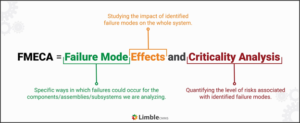Failure Mode, Effects, and Criticality Analysis (FMECA)
Everything you ever needed to know about FMECA.
What is FMECA?
Failure mode, effects, and criticality analysis (FMECA) is a cause analysis methodology commonly used to prevent failure in industrial operations. The purpose is to minimize the chances of severe system breakdowns through an in-depth risk assessment.
In this article, we’ll cover FMECA and how it works, its benefits, and best practices for using it in industrial settings.
What is FMECA and how do organizations use it?
In the 1940s, the U.S. military sought to create a methodology that would help prevent failure in certain systems (weapons, vehicles, etc.) rather than waiting for failure to occur before fixing it. The goal was to create a method for systematically identifying ways a system can fail so that an organization can prepare for – or even prevent – such failures. That was the start of FMECA.
Today, many industrial facilities use this process to anticipate and prevent failure in their own operations. This helps avoid many of the pitfalls of unexpected operational shutdowns like lost productivity and revenue.
Let’s break down each component of FMECA to understand it better:
- Failure mode: the ways something can fail or go wrong
- Effects: the effects of failure and how it will impact the whole system
- Criticality: the severity level of each failure mode
- Analysis: ranking of failures, effects, and their criticality to prioritize their prevention efforts

Organizations use FMECA to analyze their processes and assess the probability that different failure modes will occur. With this information, maintenance teams can prioritize their work, predict failure, and maximize productivity.
Since this process helps workers perform preventive maintenance before issues occur, companies can maximize their uptime and keep operations moving smoothly.
The difference between FMECA and FMEA
FMECA is FMEA (failure mode and effects analysis) with an extra step: criticality analysis.
FMEA is typically more qualitative and looks at “what if” scenarios of system failure. FMECA takes a quantitative approach by adding ranking and priority to potential failure modes, enabling maintenance teams to better focus on critical tasks.
Common applications for FMECA
Addressing failure rates and possible failure modes of systems is essential in applications across several industries.
Aerospace
Since the 1960s, aerospace contractors for NASA have used FMECA to ensure the reliability and safety of spacecraft systems. FMECA has been vital to a variety of programs, including Apollo, Viking, Voyager, Magellan, and Galileo.
Automotive
The auto industry uses FMECA to enhance vehicle reliability and safety. During the design process, analyzing failure modes in critical items like engines, brakes, and safety systems allows manufacturers to create better products and reduce the risk of costly recalls.
Healthcare
FMECA is essential to ensuring patient safety with medical devices and equipment. With FMECA, healthcare providers and manufacturers can identify potential failure modes in diagnostic tools, treatment devices, and procedures to improve quality of care.
Manufacturing
Manufacturing facilities use FMECA to improve production processes, prevent equipment breakdowns, and ensure quality products. Manufacturers identify failure modes in machinery and production lines to implement a more proactive maintenance strategy.
Nuclear power
FMECA plays a critical role in maintaining the safety and integrity of nuclear reactors and systems in the nuclear power industry. Analyzing potential failure modes in critical nuclear components helps nuclear facilities mitigate the risk of accidents and adhere to regulatory compliance.
FMECA plays a vital role in risk management, reliability engineering, and safety assurance in each of these industries. By identifying critical failure modes, assessing potential consequences, and prioritizing mitigation efforts, organizations can enhance operational efficiency, minimize downtime, and safeguard assets and personnel.
Benefits of using FMECA
Utilizing the FMECA process provides many benefits that contribute to an organization’s overall operational efficiency.
Proactive risk management
Failure detection is essential for proactive risk management. FMECA analysis helps organizations detect the probability of failure and proactively mitigate the associated risks. By addressing vulnerabilities in advance, businesses can minimize the chance of breakdowns and unplanned downtime.
Informed decision making
FMECA helps maintenance teams gain a more comprehensive understanding of failure causes and consequences. This empowers them to make more informed decisions regarding maintenance planning and resource allocation.
Improved safety and reliability
FMECA addresses vulnerabilities and provides a roadmap for organizations to implement preventive measures to minimize the risk of accidents, injuries, and equipment failures. This, in turn, creates a safer work environment for employees.
Regulatory compliance
Safety and reliability are critical factors in maintaining regulatory compliance. By using FMECA, businesses demonstrate a proactive approach to risk management and ensure compliance with industry regulations.
Cost savings
Identifying failure modes early is typically more cost-effective than taking corrective actions after a failure occurs. FMECA helps organizations proactively allocate resources to prevent potential risks and reduce the likelihood of production delays and unplanned maintenance activities.
Challenges and limitations of FMECA
While FMECA is a valuable tool for risk management and reliability engineering, it does have its own set of challenges and barriers to entry, including:
- Data availability: FMECA requires access to a wide array of accurate and reliable data for system components, failure modes, and their potential consequences. It can be difficult to obtain the data needed to complete FMECA, particularly for more complex systems.
- Intensive resources needed: Performing FMECA is time-consuming and resource-intensive. It requires significant investments in personnel, expertise, and technology.
- Complexity: As systems and subsystems grow and become more complex, so does the FMECA process. Analyzing large datasets and identifying failure modes and their domino effects requires a detailed investigation into their interconnecting parts.
- Assumption-based analysis: FMECA relies on assumptions about system behavior, which may not always be accurate. This can cause discrepancies between predicted and actual failure occurrences.
- Limited scope: FMECA primarily focuses on the technical failures within a system. It doesn’t always consider other factors that contribute to failure, such as human error, organizational factors, or external disasters.
- Difficulty prioritizing: FMECA helps prioritize failure prevention efforts based on the criticality of failure modes, but it can be challenging to determine how to best allocate resources for competing priorities.
Best practices for FMECA
Despite its challenges, FMECA is still a widely used industry resource that can provide immense value. Organizations can implement FMECA more effectively by incorporating the following best practices into their process.
Define the scope and objectives
Before beginning FMECA, identify the scope and objectives for the analysis. What system will you be analyzing? What are its functions, requirements, and specifications? What criteria are you considering for its failure modes, effects, and criticality? How will you communicate and document the results of the analysis?
Determining this information before starting the process will help avoid redundancies and unnecessary details.
Take advantage of technology
Technology can help streamline FMECA processes like data collection, analysis, maintenance planning, and implementation. Computerized Maintenance Management Systems (CMMS) can perform data management, automated risk assessments, asset management, and insight reporting.
Ensure comprehensive data collection
Organizations must gather detailed information about a system’s components, failure modes, historical data, and operational conditions. In addition to utilizing technology to help collect data, you can consult subject matter experts and obtain relevant documentation and records to ensure you have complete and accurate data.
Utilize prioritization criteria
Prioritization after FMECA can be challenging, but it is a vital step toward ensuring the process’s success. Establish clear criteria, including risk severity, safety impact, regulatory requirements, and operational criticality, to aid in prioritizing work orders and preventive tasks.
Continuously review and improve
FMECA is an ongoing process that needs continuous review and updates just like any other aspect of strategic maintenance planning. Regularly review FMECA assessments when your organization undergoes changes in technology, operating conditions, or other organizational changes to ensure the process remains relevant and effective.
Want to see Limble in action? Get started for free today!
Improve your FMECA process with Limble CMMS
FMECA is a valuable tool for improving operational efficiency and creating a safer work environment. The process is easier when you have the help of technology that can accurately collect and analyze the vast array of data that FMECA requires.
Limble CMMS can help facilitate data management, schedule maintenance tasks, and track equipment performance to more accurately predict and prevent failure. Reach out today for more information, or try our free demo.


